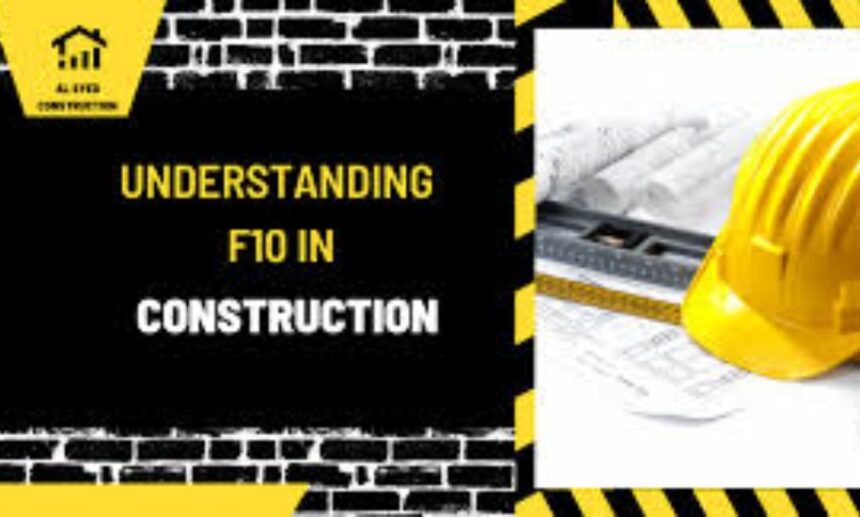The health and safety of workers on construction sites are of paramount importance. Within the context of the United Kingdom’s construction industry, Form F10, governed by the Construction (Design and Management) Regulations 2015 (CDM 2015), plays a crucial role in notifying the Health and Safety Executive (HSE) about certain types of construction projects. But the question arises: who is responsible for the F10? This article delves into the details of Form F10, its significance, and the individuals and entities responsible for ensuring its completion.
As we explore this topic, we will focus on answering this fundamental question, particularly from the perspective of UK law, with insights into how it impacts the broader scope of construction safety. We will also take a closer look at the responsibilities placed on various stakeholders involved in construction projects. Let’s begin by setting the stage for understanding the who is responsible for the F10 in the context of the UK’s regulations.
What is Form F10?
Before answering the critical question of who is responsible for the F10, it is essential to understand what Form F10 is. The F10 form is a formal document required by the Health and Safety Executive (HSE) as part of the UK’s health and safety regulations in the construction industry. Specifically, it is part of the Construction (Design and Management) Regulations 2015 (CDM 2015), which are designed to ensure that construction projects, both large and small, meet necessary safety standards.
The F10 is used to notify the HSE of a project where construction work will last for more than 30 days or involve more than 500 person-days of work. It serves to inform the authorities about the scope of the project, the anticipated risks, and the measures in place to ensure safety. By requiring notification, the F10 form allows for proper oversight from regulatory bodies throughout the lifecycle of a project.
The Legal Framework: CDM 2015 Regulations
The Construction (Design and Management) Regulations 2015 (CDM 2015) were introduced to improve health, safety, and welfare during the design and construction phases of a project. One of the critical components of CDM 2015 is the requirement to submit Form F10 to the HSE, ensuring that significant construction projects are properly regulated from the outset.
CDM 2015 places specific duties on various individuals and organizations involved in construction projects, including clients, designers, contractors, and the project’s principal designer. The purpose of these regulations is not only to manage risks but also to ensure that health and safety are prioritized at every stage of the project. Form F10 is therefore an essential tool for ensuring that these regulations are adhered to, specifically regarding the notification of larger projects that carry higher safety risks.
Who is Responsible for Completing Form F10?
Now, let’s turn to the heart of the question: who is responsible for the F10? The responsibility for completing and submitting Form F10 rests primarily with the client or the person who has control over the construction project. This includes developers, property owners, and other project stakeholders who are responsible for the project’s initiation. Under CDM 2015, clients have the duty to ensure that the appropriate notifications are made, including submitting the F10 to the HSE.
However, the client is not working in isolation. The client’s role is collaborative, and the form’s completion often involves input from other parties involved in the project. The principal designer and contractor may assist in providing the necessary information regarding the project’s scope, risks, and safety measures.
In some cases, the duty of responsibility may be delegated. For example, in complex or large-scale projects, a principal contractor or principal designer may take on the responsibility of submitting the form if the client appoints them to do so. However, the ultimate responsibility for ensuring that Form F10 is submitted correctly lies with the client, as they have the overarching responsibility for managing health and safety on the project.
When Should Form F10 Be Submitted?
The question of who is responsible for the F10 is not only about the parties involved but also the timing of the form’s submission. Under the CDM 2015 regulations, the F10 form must be submitted before the construction work begins. It should be submitted as soon as the project meets the criteria for notification—specifically, if the work will last for more than 30 days or involve more than 500 person-days of work.
In practice, this means that the responsibility of submitting the F10 lies with the client at the planning stage of the project. It is essential to notify the HSE as early as possible, as this ensures that safety regulations are considered during the project’s design phase. This early notification helps to avoid delays and ensures that the necessary precautions are put in place before construction work commences.
The Role of the Principal Designer and Principal Contractor
While the client is ultimately responsible for submitting Form F10, the principal designer and principal contractor play crucial supporting roles. The principal designer is responsible for ensuring that health and safety considerations are integrated into the project design. They are responsible for advising the client on matters related to safety during the design and planning phases.
Similarly, the principal contractor, who oversees the construction phase, must ensure that safety protocols are followed on-site. Both the principal designer and principal contractor must assist the client in ensuring that the F10 form contains all necessary information. This collaboration ensures that the form is filled out accurately and that the necessary notifications are made to the HSE on time.
The Consequences of Failing to Submit Form F10
Failure to submit Form F10 when required can have serious consequences. If the HSE is not notified of a project that meets the criteria, the client may face legal and financial repercussions. These consequences may include fines, penalties, and potential shutdowns of the construction project. Furthermore, the absence of an F10 form means that there is a lack of oversight from regulatory bodies, which could result in unsafe working conditions.
Ensuring that Form F10 is submitted in accordance with CDM 2015 is not just a matter of legal compliance; it is essential for the safety and well-being of those working on construction sites. The form serves as a tool for transparency and accountability, helping to ensure that construction projects are conducted with proper safety measures in place.
Conclusion: Ensuring Compliance and Safety in Construction
In summary, the question who is responsible for the F10 highlights the significant role that the client plays in ensuring that construction projects comply with the UK’s health and safety regulations. Form F10, governed by the Construction (Design and Management) Regulations 2015, is an essential part of ensuring that large-scale construction projects are notified to the Health and Safety Executive (HSE) in a timely and accurate manner. The client is the primary party responsible for submitting the form, but the principal designer and principal contractor are important collaborators in ensuring the form’s accuracy.
By understanding the roles and responsibilities outlined in the CDM 2015 regulations, all parties involved in a construction project can help ensure that safety is a top priority, and that the necessary precautions are taken to protect workers. Proper completion and submission of Form F10 are critical steps in maintaining the safety of construction sites across the UK.







